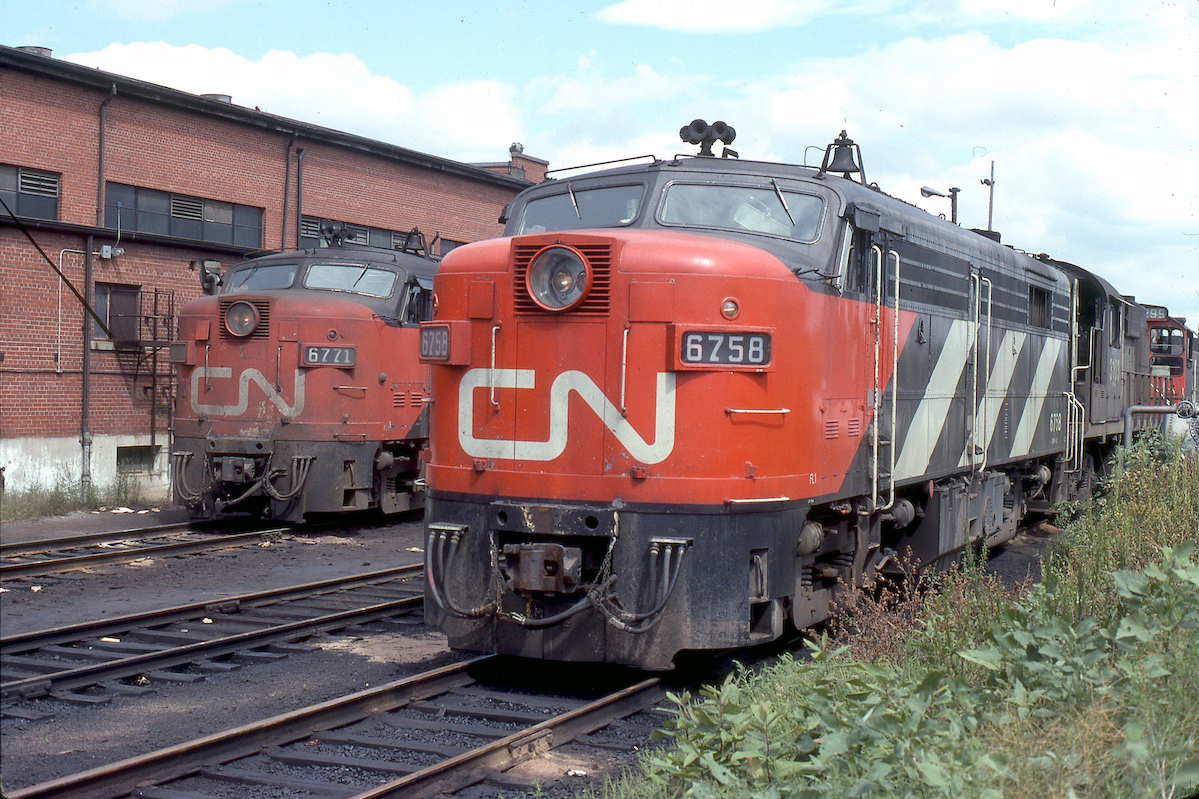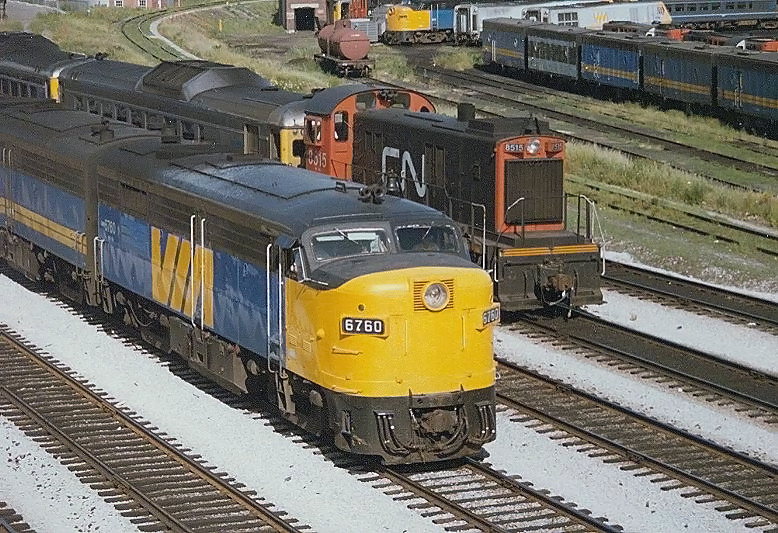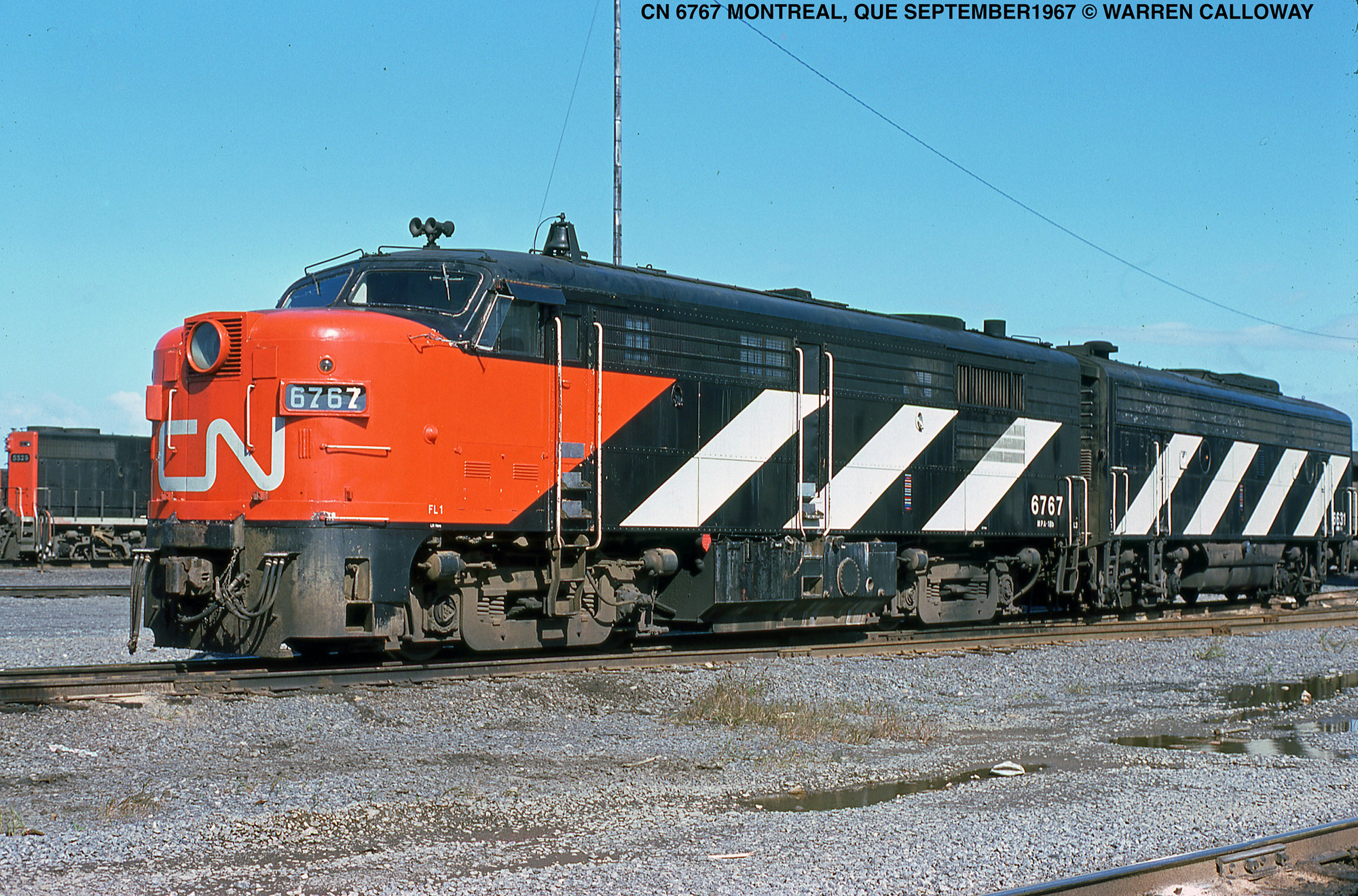MLW "FPA4" Locomotives: Specs, Roster, History
Last revised: August 28, 2024
By: Adam Burns
The FPA-4 was the Montreal Locomotive Works' final streamlined cab design and the only one to boast Alco's 251 power plant. The model was known for its robust performance and versatility, primarily designed for passenger service.
It was cataloged during the late streamlined era as North American builders continued their horsepower race. Interestingly, Alco/MLW locomotives enjoyed far longer service in Canada than in the States with some late road-switchers still in service on Canadian National and Canadian Pacific until the 1990s.
The FPA-4s were no exception, remaining in commuter service at VIA Rail until the late 1980s. Despite only a total of 46 units produced between 1958-1959, several are preserved and remain operational in excursion service within the U.S. This article delves into the history, technical specifications, operational history, and legacy of the FPA-4.
Development
MLW had a long history of producing influential steam and diesel locomotives. By the 1950s, as the transition from steam to diesel was well underway, MLW sought to develop more advanced and efficient models to meet the demands of North American railroads.
Introduced in 1958, the FPA-4 was part of MLW’s FA series, designed specifically for passenger service. This series dates back to Alco's FA-1 introduced in 1946. As John Kirkland notes in his book, "The Diesel Builders Volume Two: American Locomotive Company and Montreal Locomotive Works," Alco had produced a total of 558 units in its FA series while MLW constructed another 193 units at Montreal.
The “P” in FPA-4 denotes its passenger service orientation, distinguishing it from freight locomotives within the same series. The FPA-4 was developed as a versatile, reliable, and powerful locomotive capable of pulling heavy passenger trains across varied terrains, from flat plains to mountainous regions.
Specifications
The FPA-4 is notable for its impressive technical attributes that contribute to its performance and adaptability:
- **Powerplant:** The FA series had long utilized Alco's 244 power plant offering 1,600 horsepower. However, the FPA-4 was the first - and only - cab model to boast the new 251B engine (12 cylinder) capable of producing 1,800 horsepower.
- **Configuration:** The FPA-4 features a B-B wheel arrangement and standard drop side equalizer rigid bolster trucks (AAR Type B), typically found on all FA series models.
- **Dimensions:** "A" units measured 54 feet in length (an increase of 4 inches over previous FA models) while "B" units were 53 feet, 2 inches with weights of 260,000 pounds on average.
- **Fuel Capacity:** With a fuel capacity of 1,200 gallons, the FPA-4 can operate over long distances without the need for frequent refueling.
- **Steam Generator:** An essential feature for passenger service, the FPA-4 is equipped with a steam generator for heating passenger cars during colder months.
- **Design:** The locomotive sports a full-width carbody design with a streamlined appearance, which not only enhances aesthetics but also aerodynamics.
- **Improvements:** The FPA-4 replaced electrically driven traction motor blowers which mechanical variants. In addition, the auxiliary generator now sported a gear-driven shaft which drove the forward traction motor blower while the rear traction motor blower was mechanically powered from the radiator fan drive shaft.
Data Sheet
| Engine | |||
|---|---|---|---|
| Dominion Engineering | 251B V-12 (4-cycle) | 1800 horsepower | Bore & Stroke: 9.0" x 10.5" |
| RPM (Max / Min) | 1000 / 350 | Weight | 260,000 Lbs |
| Powertrain | |||
| Main Generator | GT581C | Traction Motors | GE-752 (four) |
| Tractive Force (starting) | 64,500 lbs @ 25% | Tractive Force (continuous) | 53,000 lbs @ 11 mph |
| Traction Motor Blowers | GY29 (2) | ||
| Trucks | |||
| Configuration | B-B (AAR Type B) | Wheel Diameter | 40" |
| Speed | 92 mph | Gear Ratio | 62:21 |
| Turning Radius (Minimum) | 21 degrees | Wheelbase | 9' 4" |
| Operation | |||
| M/U Capability | Yes | Dynamic Braking | Yes |
| Auxillary Generator | GY27 | Air Compressor | Westinghouse 3CDC |
| Air Brake | Westinghouse 24RL | ||
| Capacities | |||
| Fuel | 1200 gallons | Lubricating Oil | 200 gal. |
| Cooling Water | 50 gallons | Sand | 22 cubic feet |
| Steam Generator | 2750 lb/hr | ||
| Dimensions | |||
| FPA-4 Length | 54'-0" | FPB-4 Length | 53'-2" |
| Locomotive Wheel Base | 38'-06" | Engine Hood Height | 14'-10" |
| Cab Height* | 14'-4" | Cab Width | 9'-10.7" |
| Width over handrails | 10'-06.5" | Distance between Truck Centers | 29'-04" |
 Canadian National FPA-4s #6758 and #6771 at Montreal, Quebec in September, 1976. Warren Calloway photo.
Canadian National FPA-4s #6758 and #6771 at Montreal, Quebec in September, 1976. Warren Calloway photo.The FPA-4 was sold only to Canadian National where it played a crucial role on various routes in passenger service and was used extensively, especially on routes with challenging terrains where the rugged GE traction motors were particularly suited.
- **Versatile Service:** Besides mainline passenger service, the FPA-4 also saw use in commuter operations and mixed service where versatility was required. The entire fleet was transferred to VIA Rail for such assignments on March 31, 1978.
Its robust construction allowed it to handle the demands of different service profiles effectively. Unfortunately, the locomotives only led VIA trains for a decade.
The Canadian Ministry of Transportation announced that, effective April 1, 1989, only locomotives equipped with RSC safety control equipment would be allowed to lead VIA passenger trains. Afterwards, the units either were placed in trailing positions or retired.
Legacy
The FPA-4 has left an enduring legacy in the railroad industry, thanks to its combination of power, versatility, and reliability. Its contributions extend beyond its operational life through preservation efforts and continued use in heritage railways:
- **Preservation:** Several FPA-4 locomotives have been preserved in railway museums and heritage railways across North America. In fact, nearly a third of the original fleet survives today.
- **Heritage and Excursion Service:** Some FPA-4 units continue to operate in heritage and excursion services, allowing rail enthusiasts and the general public to experience a piece of railroad history firsthand.
Organizations operating these preserved units maintain them meticulously, ensuring they remain operational for special excursions and events.
Locations where they can still be found in operation include the Napa Valley Wine Train, Monticello Railway Museum, New York & Lake Erie Railroad (New York), Grand Canyon Railway, and the Cuyahoga Valley Scenic Railroad.
Production Roster
FPA-4 (DL-218)
Total built = 34
| Serial Number | Completion Date | Owner | Road Number |
|---|---|---|---|
| 82269-82270 | 10/1958 | Canadian National | 6760-6761 |
| 82271-82272 | 11/1958 | Canadian National | 6762-6763 |
| 82273-82275 | 12/1958 | Canadian National | 6764-6766 |
| 83145-83149 | 1/1959 | Canadian National | 6767-6771 |
| 83150-83154 | 2/1959 | Canadian National | 6772-6776 |
| 83155-83161 | 3/1959 | Canadian National | 6777-6783 |
| 83162-83169 | 4/1959 | Canadian National | 6784-6791 |
| 83170-83171 | 5/1959 | Canadian National | 6792-6793 |
FPB-4 (DL-219)
Total Built = 12
| Serial Number | Completion Date | Owner | Road Number |
|---|---|---|---|
| 82276-82277 | 10/1958 | Canadian National | 6860-6861 |
| 82278 | 11/1958 | Canadian National | 6862 |
| 82441 | 8/1958 | Canadian National | 6863 |
| 82442 | 11/1958 | Canadian National | 6864 |
| 82443-82444 | 12/1958 | Canadian National | 6865-6866 |
| 82584-82585 | 1/1959 | Canadian National | 6867-6868 |
| 82586-82587 | 2/1959 | Canadian National | 6869-6870 |
| 82588 | 3/1959 | Canadian National | 6871 |
 VIA Rail FPA-4 #6760 pulls a westbound train out of Toronto Union Station and past a Canadian National S12 switching a string of Budd RDCs on July 9, 1983. Doug Kroll photo.
VIA Rail FPA-4 #6760 pulls a westbound train out of Toronto Union Station and past a Canadian National S12 switching a string of Budd RDCs on July 9, 1983. Doug Kroll photo.Conclusion
The FPA-4 remains a significant chapter in the history of diesel-electric locomotion. Designed for passenger service, the classic cab model successfully combined power, versatility, and reliability, making it a staple on Canadian National’s passenger routes.
Its lasting legacy, preserved through continued use in heritage railways and museums, highlights the importance of such innovations in the history of railroading.
Recent Articles
-
Rio Grande 2-8-2 Locomotives (K-37): Specs, Roster, Photos
Apr 15, 25 12:57 PM
Rio Grande's Class K-37 Mikes were itsdge steamers to enter service in the late 1920s. Today, all but two survive. -
Rio Grande 2-8-2 Locomotives (K-36): Specs, Roster, Photos
Apr 15, 25 11:09 AM
The Rio Grande's K-36 2-8-2s were its last new Mikados purchased for narrow-gauge use. Today, all but one survives. -
Rio Grande 2-8-2 Locomotives (Class K-28): Specs, Roster, Photos
Apr 14, 25 10:24 PM
Rio Grande's Class K-28 Mikados were its newest narrow-gauge steam locomotives since the Mudhens of the early 1900s. Today, three survive.



